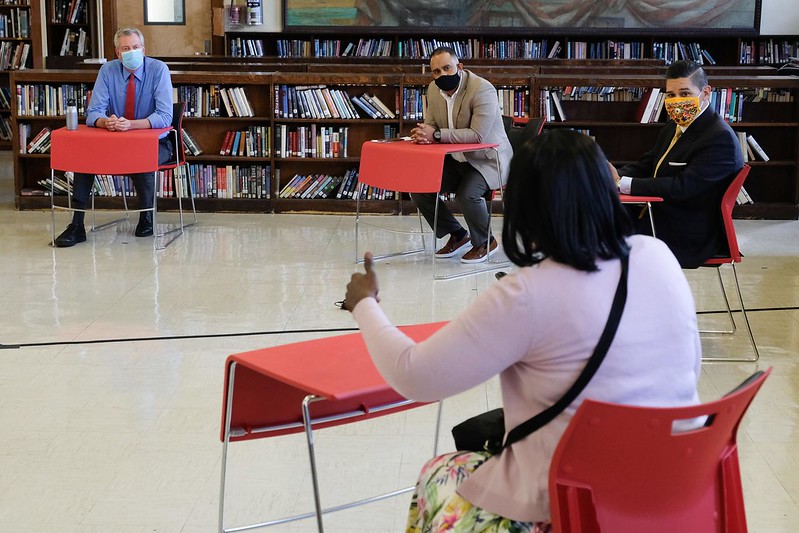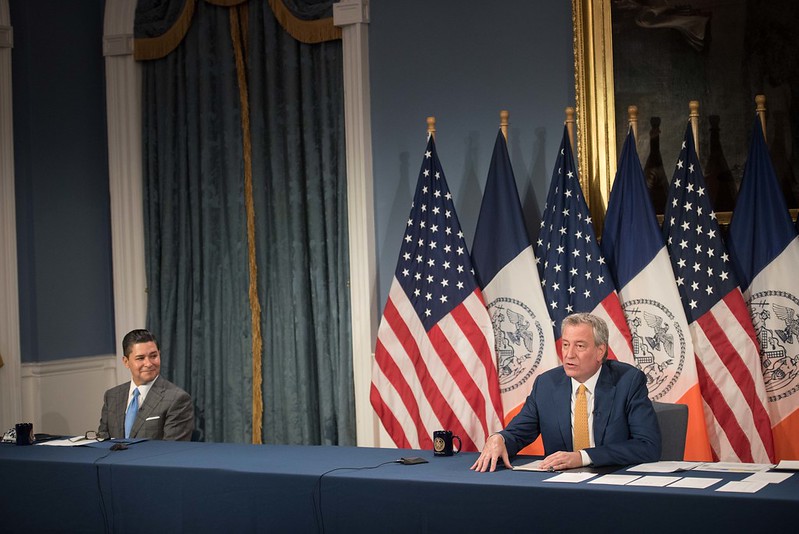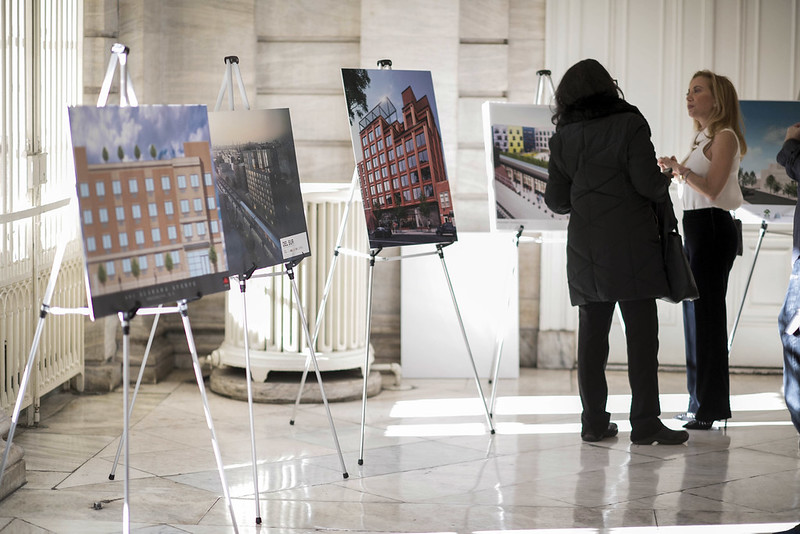For Our Most Vulnerable Families, The City Must Delay In-Person School and Improve Remote Learning

The Mayor and Chancellor visit a school (photo: Ed Reed/Mayor's Office)
Deciding if and how we reopen schools this fall has been incredibly difficult and complex for city leaders. Keeping students, teachers, and support staff safe is of paramount importance in any reopening plan — but access to the resources and support that in-person instruction provides is a lifeline for many students.
Only a few weeks out from the first day of classes, it is clear our city is not equipped to safely bring 1.1 million students back to school. For the immigrant populations and communities of color that have been disproportionately impacted by this pandemic, the weight of this decision is even heavier, and the consequences of any decision will no doubt fall harder on the most vulnerable among us.
This is a hard decision for everyone involved. But without a concrete plan to protect educators, school staff, students, and their families, Mayor de Blasio and the Department of Education must delay in-person learning.
Since the beginning of this pandemic, immigrant communities in our city have felt the full force of its destruction. Nearly one in five of the essential workers staffing New York City’s grocery stores, social services organizations, and other frontline businesses are non-citizens and more than half are foreign born. Half of the city’s working class immigrants lost their jobs due to the pandemic, but undocumented immigrants can’t take advantage of rent subsidies or food stamps and did not receive a federal stimulus check. Health disparities that existed far before the pandemic have been exacerbated, with Black and Latino New Yorkers dying from the virus at about twice the rate of white New Yorkers.
Any decision about schools reopening needs to take into account how vulnerable these populations have already been to COVID-19 and place their needs front and center. Like many immigrant families, when I came to this country at age 12, I lived in a multi-generational home with my parents and grandmother. For our families, sending kids to school not only puts them and their parents at risk, but makes it harder to protect our senior population, especially those with pre-existing conditions. I came here without even knowing the alphabet, and it was through the support of my grandmother and teachers at my New York City public schools that I learned English and succeeded in the classroom.
If our schools don’t reopen for in-person learning, there are a number of challenges we still need to address. Many students lack internet access, live in crowded apartments, or are English language learners who need in-person support. Any remote learning or hybrid reopening model must ensure that immigrants and students of color have full access to the resources and technology they need to succeed in an online setting and address the ongoing child care crisis that has left parents with an impossible set of choices. The city must continue providing free child care for essential workers and any other parents who need assistance throughout this pandemic.
Most importantly, it is critical that the Department of Education and city officials keep an open line of communication with parents and students, ensuring that immigrant families have access to resources and guidance in the languages they are most comfortable with. The DOE should follow guidance from the New York Immigration Coalition Education Collaborative, which put forward a comprehensive communications plan that prioritizes reaching immigrant families, those with limited English proficiency, and parents who have low digital literacy. The DOE needs to reach these families where they are, and quickly.
Educators and workers have told us that schools can be reopened safely, but they will require adequate funding for PPE, cleaning supplies, and proper ventilation. So far, the Department of Education has not shared detailed plans or resource commitments. Little to no information about the proposed child care program that thousands of parents will depend on has been released. Just weeks before classes start, the Mayor announced that schools can include outdoor classrooms and should plan accordingly, but provided no road map. It’s clear that the DOE still does not have a clear plan, and teachers and parents are operating in the dark.
There is far too much at risk — especially for immigrants and communities of color who have already suffered so much — for the nation’s largest school district to make such a monumental decision without being fully prepared. Until we have a real plan in place, we must delay in-person learning and focus on ensuring that remote learning is as effective as possible, for all communities.
***
By Jenny Low, Reporter, Gotham Gazette
@jennylamlow.
***
Have an op-ed idea or submission for Gotham Gazette? Email This email address is being protected from spambots. You need JavaScript enabled to view it.
The Schools Chancellor Must Step Up or Step Aside

Mayor de Blasio & Chancellor Carranza (photo: Mayor's Office)
Unless there's an unexpected, immediate turnaround, New York City's public schools need new leadership.
Poorly planned March closures, Spring and Summer distance learning failures, and overwhelmingly confused reopening plans for Fall are evidence of a system in near collapse and the cause of widespread parent and teacher despondency.
This is not all Chancellor Richard Carranza's fault. He works for a Mayor who has been slow and stubborn throughout the city's pandemic response, especially when it comes to the schools. But Mayor Bill de Blasio still has a year and a half left in office and our schools need new leadership now. We need a new Chancellor who will stand up to the Mayor, demonstrating managerial decisiveness and instructional vision. Deferring to de Blasio at every turn is a calamity for our children who face a perilous educational future.
Mayoral control of the city's schools makes the Chancellor's independence difficult. But Police Commissioner Dermot Shea regularly challenges the Mayor and gets away with it. Education is no less a technical field than policing. Carranza, however, has shown little backbone to chart his own course over the past two-and-a-half years and especially for the past six months. He needs to step up or step aside for a stronger replacement.
There is little chance that de Blasio will remove the Chancellor, a loyal soldier. Some will question changing horses mid-stream. But when the water is rising and the Mayor with the Chancellor at his side are stuck, the only choice is to spur change. So, without new-found independence, it remains for Carranza to leave, allowing new leadership to move us forward.
Carranza's greatest and most lasting legacy has been calling out our system's structural racism. He dared utter the word "segregation" when it stuck in de Blasio’s throat. He called for dismantling screened schools. He appointed people of color and women to high positions. No Chancellor in history has been more forceful in their calls for a more just and equal school system.
Those words, though, have not been followed by sufficient action. Here again, perhaps held back by the Mayor, Carranza has not met the moment. He has lagged, rather than led, as a few community school districts made strides improving diversity. Screened schools still promote segregation. Implicit bias training has been overly expensive and of dubious effectiveness. Two reports by the School Diversity Advisory Group have largely been shelved, especially the most significant integration recommendations. Now, inequities accumulate in haphazard reopening plans and budget cuts visited on the most vulnerable. Having broken through on rhetoric, stronger leadership is required to turn verbal commitments into reality.
De Blasio ran out of educational gas with his inspired first burst of effort bringing truly universal pre-kindergarten to New York. But Chancellor Fariña merely reversed Bloomberg-era reforms and Carranza has shown little ability to make strides in either instruction or bureaucratic responsiveness. Many outstanding educators wait in the wings to bring extensive leadership experience, new energy, and independent ideas to our schools. Among them are First Deputy Chancellor Don Conyers, Rhode Island Education Commissioner Angélica Infante-Green, and ex-Montgomery County, Maryland Superintendent Josh Starr, who all have enviable track records within the New York City Department of Education and could immediately step into the Chancellorship.
If.
If de Blasio can suppress his arrogance and admit he is no educational expert, allowing a new Chancellor to choose his or her own team and set a course outside the political calculus of City Hall.
If Chancellor Carranza has the courage to step up or see that he has brought us to where we are but can go no further.
If we, under new leadership, can reclaim our sense of hope and confidence instead of fear and confusion about this traditional time of renewal, the new school year.
***
David C. Bloomfield is Professor of Educational Leadership, Law, and Policy at Brooklyn College and The CUNY Graduate Center. On Twitter @BloomfieldDavid.
***
Have an op-ed idea or submission for Gotham Gazette? Email This email address is being protected from spambots. You need JavaScript enabled to view it.
Eradicating Visible and Invisible Racism in Housing

(photo: Ed Reed/Mayoral Photography Office)
“Segregation now, segregation tomorrow, and segregation forever,” declared Alabama Governor George Wallace in 1963. This racist trope pandered to white voters and could not have been clearer, just as recent remarks by President Donald Trump were to white suburban voters.
Trump contends that implementing an Obama-era federal housing department rule designed to assist all communities (not just suburbs) to meet their legal obligation under the 1968 Fair Housing Act to “affirmatively further fair housing” (AFFH) will “totally destroy the beautiful suburbs.” The president asserts that the AFFH rule would force communities to accept low-income housing which, in turn, would rapidly increase crime and lower property values. As numerous studies have shown, this is patently untrue. But to people who utter such racist nonsense, facts rarely matter.
We should not be surprised that a president whose business was prosecuted for alleged racial discrimination in housing in the 1970s does not believe fair housing laws should be enforced. Apparently, this self-described “law and order” president cherry picks the laws he wants enforced and our nation’s civil rights laws are not even on his list.
Housing and Urban Development (HUD) Secretary Ben Carson has also opposed the AFFH rule, stating that addressing the inequalities resulting from structural and historical racism would be a “waste of time” and dismissed the rule as “social engineering.” Ironically, he appears oblivious to the fact that it was a massive, intentional, coordinated, and costly social engineering effort over more than half-a-century by the real estate industry and government at all levels that constructed the architecture of residential racial segregation that remains so durable and visible in our metropolitan regions.
This legacy of discrimination, which explicitly preserved and protected white neighborhoods and white economic interests to the disadvantage and exclusion of African-American people, was responsible for creating the racial wealth gap that persists to this day. Congress included the duty to affirmatively further fair housing in the Fair Housing Act to ensure that, going forward, the federal government and recipients of federal funds would take meaningful steps to ensure that housing and community development policies and programs reduced residential racial segregation and repaired the harm caused by past government action. This administration’s action to set aside this rule and eviscerate a key provision of the Fair Housing Act must not be allowed to stand.
As a nation, we also need to eliminate less visible forms of systemic racism in housing that persist to this day. The late civil rights leader James Farmer Jr. stated, “Institutional practices, it seems, perpetuate themselves mostly by their invisibility.”
In November 2019, Newsday released the results of the largest journalistic testing investigation into real estate practices conducted in the nation. Newsday documented racial steering and found that, nearly half of the time (49%), African-American home-buyers experienced racial discrimination when searching for a home to purchase on Long Island. In July 2020, Suffolk University Law School reported on the results of an undercover testing investigation completed in the Boston area that found Black renters encountered less favorable treatment than their white counterparts 71% of the time. Decades of testing investigations conducted by fair housing organizations provide compelling evidence that systemic racism remains a persistent and pervasive characteristic in our metropolitan housing markets. But the subtle nature of contemporary housing discrimination makes it virtually impossible for ordinary consumers to detect.
Government enforcement of fair housing laws has been largely passive and uneven over the past 52 years. Past Republican and Democratic administrations can be roundly criticized for treating fair housing with abject neglect. But the Trump administration has mounted an overtly racist attack on fair housing by advancing two destructive regulations, one that provides an utterly fatuous redefinition of what it means to affirmatively further fair housing and another that makes it virtually impossible to use the well-established legal theory of disparate impact to enforce fair housing laws. Repairing the damage this administration has done to our fair housing laws will require that the next administration rescind these vile regulations as part of a larger racial justice agenda.
In a recent Los Angeles Times op-ed, Kareem Abdul-Jabbar powerfully wrote, "Racism in America is like dust in the air. It seems invisible — even if you’re choking on it — until you let the sun in. Then you see it’s everywhere. As long as we keep shining that light, we have a chance of cleaning it wherever it lands. But we have to stay vigilant, because it’s always still in the air."
As a nation, we must shine a bright light on discriminatory housing policies and practices and work to cleanse our housing markets of pernicious systemic racism. This will mean devoting significant resources to vigorously enforce and fully implement fair housing laws. If this is going to happen, our first cleaning project should be the White House.
***
Fred Freiberg is Executive Director of the New York City-based Fair Housing Justice Center.
***
Have an op-ed idea or submission for Gotham Gazette? Email This email address is being protected from spambots. You need JavaScript enabled to view it.




